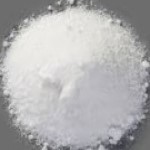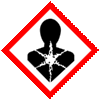Boric Acid SDS of Suppliers Exporters, Manufacturers
Boric Acid
CAS Number: 10043-35-3 USP NF BP Ph Eur Reagent Grade Suppliers Exporters, Manufacturers

Please visit Main Page of Boric Acid USP NF BP Ph Eur Reagent Grade Manufacturers.
Boric Acid SDS, Safety Data Sheet
MSDS Sheet 08-May-22
1. Product Identification
Product Name & Other Names: Boric Acid or ortho-Boric acid or Boracic acid (H3BO3).
CAS No.: 10043-35-3
EINECS EC Number: 233-139-2
Relevant uses and uses advised against (if any): Industrial use only.
Supplier: As per letterhead.
2. Hazards Identification
GHS, Globally Harmonized System Classification in accordance with 29 CFR 1910
Classification according to Regulation (EC) No 1272/2008
Reproductive toxicity Category 1A, 1B - H360
Labeling according to GHS & Regulation (EC) No 1272/2008
GHS Label Elements  Health Hazard |
Signal Words: Danger
Hazard statements:
H360: May damage fertility or the unborn child.
Precautionary statements:
P201: Obtain special instructions before use.
P202: Do not handle until all safety precautions have been read and understood.
P281: Use personal protective equipment as required.
P308+313: IF exposed or concerned: Get medical advice/attention.
P405: Store locked up.
P501: Dispose of contents/container to authorized agents only.
Products containing Boric Acid are not intended for ingestion. Boric Acid has a low acute toxicity. Tiny amounts swallowed accidentally are not likely to cause effects; swallowing copious amounts may cause gastrointestinal symptoms.
3. Composition/Information on Ingredients
Product Name & Other Names: Boric Acid or ortho-Boric acid or Boracic acid or (H3BO3).
CAS No.: 10043-35-3
EINECS EC Number: 233-139-2
4. First Aid Measures
Always seek medical attention after first aid measures are provided.
Inhalation: Remove to fresh air. If not breathing, give artificial respiration. If breathing is difficult, give oxygen. Call a physician.
Ingestion: Do NOT induce vomiting unless directed to do so by medical personnel. Never give anything by mouth to an unconscious person. Loosen tight clothing such as a collar, tie, belt, or waistband. Get medical attention if symptoms appear.
Skin Contact: Remove any contaminated clothing. Wash skin with soap or mild detergent and water for at least 15 minutes. Get medical attention if irritation develops or persists. Wash cloths and Shoes before re-use.
Eye Contact: Check for and remove any contact lenses. In case of contact, immediately flush eyes with plenty of water for at least 15 minutes. Cold water may be used. Get medical attention.
Note to physicians: Observation only is required for adult ingestion of less than 6 grams of boric acid. For ingestion more than 6 grams, maintain adequate kidney function and force fluids. Gastric lavage is recommended for symptomatic patients only. Hemodialysis should be reserved for massive acute ingestion or patients with renal failure.
5. Fire Fighting Measures
Fire: It is not considered to be a fire hazard. It is a flame retardant.
Fire Extinguishing Media: Use any means suitable for extinguishing surrounding fire. Use water spray, alcohol-resistant foam, dry chemical, or carbon dioxide.
Special hazards arising from the substance or mixture: Borane/boron oxides
Extinguishing Media Not recommended: Avoid using solid water jet as it may scatter the fire.
Special Information: In the event of a fire, wear full protective clothing and NIOSH-approved self-contained breathing apparatus with full face piece operated in the pressure demand or other positive pressure mode. At elevated temperatures under fire conditions, it may produce toxic or irritating fumes. Fire-extinguishing work is done from the windward and the suitable fire-extinguishing method according to the surrounding situation is used.
6. Accidental Release Measures
Personal precautions, protective equipment, and emergency procedures: Ventilate area of leak or spill. Avoid breathing dust/fumes/gas/mist/vapors/spray. Use individual protective equipment (waterproof boots, suitable protective clothing, safety glasses, etc.). Do not approach facing the wind.
Environmental precautions: Do not let the product enter drains, soil, or water sources.
Methods and materials used for containment cleanup procedures and Storage: Contain spilled material. Cover with an inert, non-combustible absorbent material, (e.g., sand, earth, diatomaceous earth, vermiculite). Vacuum or sweep-up and remove to an approved disposal container. Finish cleaning by spreading water on the contaminated surface and allow to evacuate through the sanitary system.
7. Handling and Storage
Precautions for safe handling: Apply according to good manufacturing and industrial hygiene practices. Ensure proper ventilation. In case of insufficient ventilation, wear suitable respiratory equipment. Wash thoroughly after handling. Do not drink, eat, or smoke while handling. Avoid contact with skin, eyes, and clothing. Minimize dust generation. Avoid breathing dust/fumes/gas/mist/vapors/spray. Use individual protective equipment (waterproof boots, suitable protective clothing, safety glasses, etc.).
Conditions for safe storage, including any incompatibilities: Store in cool, dry, and ventilated area away from heat sources and protected from sunlight in tightly closed original container. Keep air contact to a minimum. Store protected from heat, sparks and ignition sources and incompatible materials. Do not store with incompatible materials like potassium, acetic anhydride, alkalis, carbonates, and hydroxides. Keep in a well closed container stored under cold to warm conditions, 2C to 40 C, (36 to 104F). Carbon steel or aluminum containers are suitable for storage. Stainless steel is needed for moist conditions.
8. Exposure Controls/Personal Protection
Airborne Exposure Limits:
Occupational exposure limits for dust (total and resizable) are treated by OSHA, Cal OSHA and ACGIH as “Particulate Not Otherwise Classified” or “Nuisance Dust”
ACGIH/TLV 10 mg/m3; Cal OSHA/PEL 10 mg/m3; OSHA/PEL (total dust) 15 mg/m3; OSHA/PEL (respirable dust) 5 mg/m3
Ventilation System: A system of local and/or general exhaust is recommended to keep employee exposures as low as possible.
Personal Respirators (NIOSH Approved): For conditions of use where exposure to dust or mist is apparent and engineering controls are not feasible, a particulate respirator (NIOSH type N95 or better filters) may be worn.
Skin Protection: Gloves and lab coat, apron, or coveralls.
Eye Protection: Use chemical safety goggles. Maintain eye wash fountain and quick-drench facilities in work area.
Other Control Measures: Maintain good housekeeping in work area. Handle in accordance with good industrial hygiene and safety practice.
9. Physical and Chemical Properties
Appearance: Boric Acid is white powder or granules.
Odor: Odorless.
Odor threshold: Not applicable.
pH: 5.1 Aqueous solution: (0.1M)
Relative density: around 1.43
Boiling Point: Decomposes.
Melting Point: 169C (336F)
Flash point: No data found.
Auto-ignition temperature: No data found.
Decomposition temperature: No data found.
Upper/lower flammability or explosive limits: No data found.
Vapor Pressure (mm Hg): 2.6 @ 20C (68F)
Vapor density: No data found.
Evaporation rate: No data found.
Flammability (solid, gas): No data found.
Partition coefficient: n-octanol/water: No data found.
Solubility: 1g/18mL in cold water.
Viscosity: No data found.
Molecular Weight: 61.8
Chemical Formula: H3BO3
10. Stability and Reactivity
Stability: It is stable under ordinary conditions of use and storage. If moisture is present, boric acid can be corrosive to iron.
Hazardous Decomposition Products: Loses chemically combined water upon heating, forming metaboric acid (HBO2) at 212-221F, then pyroboric acid (H2B4O7) at 285-320F, and Boric anhydride at higher temperatures.
Hazardous Polymerization: Will not occur.
Incompatibilities: Potassium, acetic anhydride, alkalis, carbonates, and hydroxides.
11. Toxicological Information
Toxicological Data: Oral rat LD50: 2660 mg/kg; LD50 in rabbits is greater than 2,000 mg/kg of body weight.
Oral woman LDLo: 200 mg/kg; investigated as a mutagen, tumorigen, reproductive effector.
Reproductive Toxicity: May impair fertility. May cause harm to the unborn child.
Carcinogenic Effects: Not a reported carcinogen by IARC, NTP, ACGIH, OSHA.
12. Ecological Information
Toxicity to fish:
LC50 - Ptychocheilus lucius - 279 mg/l - 96 h;
LC0 - Lepomis macrochirus (Bluegill) - > 1.021 mg/l - 96 h
Toxicity to daphnia and other aquatic invertebrates:
LC50 - Daphnia magna (Water flea) - 53,2 mg/l - 21 d
EC50 - Daphnia magna (Water flea) - 133 mg/l - 48 h
Environmental Toxicity: This material may be toxic to aquatic life.
Persistence and Degradability: No data found.
Mobility: No data found.
Bioaccumulation/ Accumulation: No data found.
Results of PBT and vPvB assessment: No data found.
13. Disposal Considerations
Whatever cannot be saved for recovery or recycling should be managed in an appropriate and approved waste disposal facility.
14. Transport Information
DOT USA, TDG Canada & ADR/RID Europe: Not regulated.
IMDG/IMO: Not regulated.
IATA/ICAO: Not regulated.
15. Regulatory Information
It should be noted that borates are safe under conditions of normal handling and use. They are essential nutrients to plants, and research shows that they play a beneficial role in human health.
USA:
SARA 311/312: See section 2.
California Prop. 65 Components: This product does not contain any chemicals known to State of California to cause cancer, birth defects, or any other reproductive harm.
16. Other Information
Disclaimer:********************************
Our company provides this SDS information sheet contained herein in good faith but makes no representation as to its comprehensiveness or accuracy. This Boric Acid SDS sheet is intended only as a guide to the appropriate precautionary handling of the material by a professionally trained person using this product. Individuals receiving the information must exercise their independent judgment in determining its appropriateness for a particular purpose.
********************************
Please visit Technical Data Sheet of Boric Acid USP NF BP Ph Eur Reagent Grade Suppliers.
Boric Acid CAS Number 10043-35-3 & Borax or Sodium Borate CAS Number 1303-96-4 Supplier Exporter, Manufacturer:
Annie Chemie P Ltd
Mumbai 4000010, INDIA
With Agents and offices in UAE, USA, Europe.
e-mail: info@anniechemie.com
Copyright and Usual Disclaimer is Applicable.
May 29, 2025
Exporters to USA, Canada, UK, Europe, UAE, Nigeria, Algeria, Turkey, Mexico, Brazil, Chile, Argentina, Australia, Dubai etc.
Perfection is made up of small things and that is a big thing.
